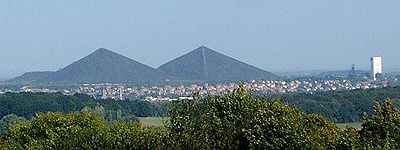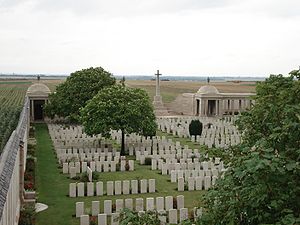
Loos-en-Gohelle
Encyclopedia
Loos-en-Gohelle is a commune
in the Pas-de-Calais department in the Nord-Pas-de-Calais region of France
.
town, three miles northwest of the centre of Lens, at the junction of the D943 and the A21 autoroute
. Its nearest neighbours are Lens
to the south, Grenay
to the west, Hulluch
to the northeast and Bénifontaine
to the east. The two largest (184m & 182m) spoil heaps in Europe are found here.

), it was decided to add the region’s name (Gohelle) to that of the commune.
The oldest documents that specify the existence of Loos date from the eleventh century, at the time of construction of the abbey of Anchin. But with the foundation of a church dedicated to Saint Vaast, it suggests that the village existed long before (St. Vaast lived in the 6th century).
By the Middle Ages
, Loos-en-Gohelle was a large village whose inhabitants lived mainly by farming: in 1569, 350 inhabitants, in 1759, 600 people ; In 1824, 700 inhabitants and in 1850 around 800 people.
It was around 1850 that the town started to become prosperous; farmers could fertilize previously uncultivated land, thanks to technology provided by Guislain Decrombecque and the discovery of coal resulted in a very rapid increase of population.
Many monuments and cemeteries reflect the destruction during World War I
which completely destroyed the town, particularly during the Battle of Loos
, from the 25th September - 8 October 1915. At the end of the war, not a single building or tree had survived the pounding of artillery. Reminders of the war persist with the periodic discovery of unexploded ordnance.
The mining infrastructure, industry and transport were hit again during World War II
.
In recent years, Loos has experienced another kind of destruction: that of the mining towns (about 1000 homes have been demolished in the recent past) as the population has left seeking work elsewhere. These tragedies could have removed Loos from the map of France, but each time, man has decided otherwise. Loos has been reborn 5 times, and is still undergoing transformation. Unfortunately nothing remains of the past.
Coal
was mined here from 1855 until 1986. The very rural village changed into a town, with many foreign workers, especially from Poland
, swelling the workforce. A former mining site (Écopole) has been preserved and now hosts many cultural, economic and environmental activities which are the symbol of new developments for the commune. Écopole 11/19 comprises buildings dating from 1923 and a modern concrete winding tower (height 66m) which operated from 1960 to 1986.
The landscape is still marked by enormous spoil heaps, those of pits 11 and 19, visible for miles around.
Nowadays, Loos-en-Gohelle is a town whose economy is dominated by light industry, textiles and workshops for artisans and professionals, but it also still retains a strong rural connection (there are thirty farms within the commune).

Communes of France
The commune is the lowest level of administrative division in the French Republic. French communes are roughly equivalent to incorporated municipalities or villages in the United States or Gemeinden in Germany...
in the Pas-de-Calais department in the Nord-Pas-de-Calais region of France
France
The French Republic , The French Republic , The French Republic , (commonly known as France , is a unitary semi-presidential republic in Western Europe with several overseas territories and islands located on other continents and in the Indian, Pacific, and Atlantic oceans. Metropolitan France...
.
Geography
A former coal miningCoal mining
The goal of coal mining is to obtain coal from the ground. Coal is valued for its energy content, and since the 1880s has been widely used to generate electricity. Steel and cement industries use coal as a fuel for extraction of iron from iron ore and for cement production. In the United States,...
town, three miles northwest of the centre of Lens, at the junction of the D943 and the A21 autoroute
A21 autoroute
The A21 autoroute is a toll free highway in north western France it is also known as the Rocade Minière.-Completed:*01 D301 Start of autoroute Towns at junction with D937 Towns served: Barlin...
. Its nearest neighbours are Lens
Lens, Pas-de-Calais
Lens is a commune in the Pas-de-Calais department in northern France. It is one of France's large Picarde cities along with Lille, Valenciennes, Amiens, Roubaix, Tourcoing, Arras, and Douai.-Metropolitan area:...
to the south, Grenay
Grenay, Pas-de-Calais
Grenay is a commune in the Pas-de-Calais department in the Nord-Pas-de-Calais region of France.-Geography:An ex-coalmining and light industrial town situated some northwest of Lens, at the junction of the D165 and the D58.-Population:...
to the west, Hulluch
Hulluch
Hulluch is a commune in the Pas-de-Calais department in the Nord-Pas-de-Calais region of France.-Geography:An ex-coalmining town, now a farming commune, situated some north of Lens, at the junction of the D947 and the D39 roads.-History:...
to the northeast and Bénifontaine
Bénifontaine
Bénifontaine is a commune in the Pas-de-Calais department in the Nord-Pas-de-Calais region of France.-Geography:A farming village situated just north of Lens at the junction of the N47 and D39 roads...
to the east. The two largest (184m & 182m) spoil heaps in Europe are found here.

History
The place was first documented in 1071, as "Lohes". The name has changed considerably over the years: Lothae, Lo, Lohes, Loes, Loez and Loos. It was not until 1791 that the name of "Loos" was officially sanctioned. According to some, the name comes from the Germanic "Lôh" and Dutch "Loo" which mean "wood", but there is no archaeological evidence of what could have been a forest. According to others, the name derives from the Germanic "Laupo" which means marshy meadows, which, given the topography of the town, tends to support this theory. In 1937, after much confusion with Loos-lez-Lille (today LoosLoos, Nord
-References:* -External links:*...
), it was decided to add the region’s name (Gohelle) to that of the commune.
The oldest documents that specify the existence of Loos date from the eleventh century, at the time of construction of the abbey of Anchin. But with the foundation of a church dedicated to Saint Vaast, it suggests that the village existed long before (St. Vaast lived in the 6th century).
By the Middle Ages
Middle Ages
The Middle Ages is a periodization of European history from the 5th century to the 15th century. The Middle Ages follows the fall of the Western Roman Empire in 476 and precedes the Early Modern Era. It is the middle period of a three-period division of Western history: Classic, Medieval and Modern...
, Loos-en-Gohelle was a large village whose inhabitants lived mainly by farming: in 1569, 350 inhabitants, in 1759, 600 people ; In 1824, 700 inhabitants and in 1850 around 800 people.
It was around 1850 that the town started to become prosperous; farmers could fertilize previously uncultivated land, thanks to technology provided by Guislain Decrombecque and the discovery of coal resulted in a very rapid increase of population.
Many monuments and cemeteries reflect the destruction during World War I
World War I
World War I , which was predominantly called the World War or the Great War from its occurrence until 1939, and the First World War or World War I thereafter, was a major war centred in Europe that began on 28 July 1914 and lasted until 11 November 1918...
which completely destroyed the town, particularly during the Battle of Loos
Battle of Loos
The Battle of Loos was one of the major British offensives mounted on the Western Front in 1915 during World War I. It marked the first time the British used poison gas during the war, and is also famous for the fact that it witnessed the first large-scale use of 'new' or Kitchener's Army...
, from the 25th September - 8 October 1915. At the end of the war, not a single building or tree had survived the pounding of artillery. Reminders of the war persist with the periodic discovery of unexploded ordnance.
The mining infrastructure, industry and transport were hit again during World War II
World War II
World War II, or the Second World War , was a global conflict lasting from 1939 to 1945, involving most of the world's nations—including all of the great powers—eventually forming two opposing military alliances: the Allies and the Axis...
.
In recent years, Loos has experienced another kind of destruction: that of the mining towns (about 1000 homes have been demolished in the recent past) as the population has left seeking work elsewhere. These tragedies could have removed Loos from the map of France, but each time, man has decided otherwise. Loos has been reborn 5 times, and is still undergoing transformation. Unfortunately nothing remains of the past.
Coal
Coal
Coal is a combustible black or brownish-black sedimentary rock usually occurring in rock strata in layers or veins called coal beds or coal seams. The harder forms, such as anthracite coal, can be regarded as metamorphic rock because of later exposure to elevated temperature and pressure...
was mined here from 1855 until 1986. The very rural village changed into a town, with many foreign workers, especially from Poland
Poland
Poland , officially the Republic of Poland , is a country in Central Europe bordered by Germany to the west; the Czech Republic and Slovakia to the south; Ukraine, Belarus and Lithuania to the east; and the Baltic Sea and Kaliningrad Oblast, a Russian exclave, to the north...
, swelling the workforce. A former mining site (Écopole) has been preserved and now hosts many cultural, economic and environmental activities which are the symbol of new developments for the commune. Écopole 11/19 comprises buildings dating from 1923 and a modern concrete winding tower (height 66m) which operated from 1960 to 1986.
The landscape is still marked by enormous spoil heaps, those of pits 11 and 19, visible for miles around.
Nowadays, Loos-en-Gohelle is a town whose economy is dominated by light industry, textiles and workshops for artisans and professionals, but it also still retains a strong rural connection (there are thirty farms within the commune).
Population
| 1962 | 1968 | 1975 | 1982 | 1990 | 1999 | 2006 |
|---|---|---|---|---|---|---|
| 7522 | 7733 | 6958 | 6706 | 6561 | 6992 | 6904 |
| Census count starting from 1962: Population without duplicates | ||||||
Places of interest
- The church of St.Vaast, rebuilt, as was the rest of the town, after the First World War.
- The war memorials.
- Écopole 11/19
- The Commonwealth War Graves CommissionCommonwealth War Graves CommissionThe Commonwealth War Graves Commission is an intergovernmental organisation of six independent member states whose principal function is to mark, record and maintain the graves, and places of commemoration, of Commonwealth of Nations military service members who died in the two World Wars...
cemeteries.


